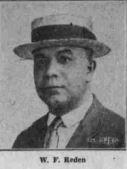William Reden and the Formation of the NAACP’s Sioux Falls Chapter

W.E.B. Du Bois, African American sociologist, historian, and editor of The Crisis magazine, carried a rich correspondence with William Reden. Why did Du Bois write the Black lawyer and Sioux Falls resident? Because Reden served as an officer of the NAACP's local chapter there.
Although significant acts of racial violence were rare, Sioux Falls had an incident of near lynching on the night of July 30, 1910. William Brown was an African American man working at the John Morrell & Co. meat packing plant when he went downtown Sioux Falls for a drink at Henry Levinger's saloon. Brown felt intimidated when a group of White men made jokes about his attire. Brown flashed a revolver at the men and left the premises. The police were notified after threats were exchanged. An angry mob of White residents paraded through the streets that night in Sioux Falls, calling for the hanging of Brown. Before dawn, two policemen found Brown. In an exchange of gunfire, one officer was injured, and Brown was dead. Reverend R. B. Manley of the African Methodist Episcopal Church in Yankton and Sioux Falls disavowed the violence, but the incident put African American residents on edge. During times of strife, the Sioux Falls chapter of the NAACP emerged to provide legal, economic, and social support for the Black community.
The National Association for the Advancement of Colored People (NAACP) was created one year before the Brown incident amid the Progressive Era, when reformers sought to address societal ills resulting from industrialization and urbanization. Unfortunately, renewed racism was a societal response to African Americans who migrated to northern cities to take advantage of new factory jobs. A Sioux Falls branch of the NAACP began around 1920 following the lynching of a Black man in Omaha, Nebraska. The local organization was created and led by "concerned citizens of both races as well as the local Jewish community." A year later, the Ku Klux Klan formed Sioux Falls, marching in a downtown parade in 1924. The KKK was publicly known for its attempts to cover racist ideals with American patriotism. Bessie Vaughn, an African American resident of Sioux Falls since 1905, remembered the burning of wood crosses during Klan meetings atop the hill near Minnesota Ave., but she noted the Klan activities did not bother the Black community. Instead, the KKK favored harassing Catholic and Jewish immigrants.
The Sioux Falls chapter of the NAACP tended to focus on job opportunities, especially during the economic woes of the Great Depression. During the 1930s, 172 African Americans left the state of South Dakota looking for work. Many of those who stayed in Sioux Falls survived through the assistance of the NAACP's members. Louisa Mitchell, one of the founders of the local NAACP chapter, encouraged African American residents to enter into cosmetology.
Another influential NAACP member was Louisa's brother William F. Reden. Reden was born in 1885 in Rock Island, Illinois, and graduated from the University of Iowa Law School in 1909. Three years after graduating, Reden helped in the founding of Delta Industrial Institute of Missouri. During Reden's fifteen years as the Institute's principal, he traveled to Sioux Falls numerous times to visit his sister. On these trips, Reden publicly spoke on solutions to the Missouri River flooding and on behalf of African American farmers wanting a fair chance in the local commerce.
Reden moved to Sioux Falls, South Dakota, in 1924, to live with his sister Louisa out of concern for his health. Living in Sioux Falls, Reden worked with the Sioux Falls police department as a research attorney on a government project. Following Reden's relocation, he took up work in education again. In addition to his work as a lawyer, Reden was with the adult education division of Works Progress Administration, a New Deal program. Serving as the Sioux Falls NAACP Branch secretary, Reden worked with his sister fighting for social justice through support of court cases. In 1942, Reden passed away due to complications of a heart condition.
As a local officer, Reden regularly wrote to W.E.B. Du Bois, editor of the national NAACP magazine The Crisis. The first correspondence of Reden and Du Bois dates back to July 26, 1919, concerning the matter of lynchings in the South. Letters pick up again between the two in 1929, after Reden had moved to Sioux Falls. Reden asked Du Bois for support for the Federal Farm Bureau in Sioux Falls. Du Bois also reached out to Reden and Louisa Mitchell concerning the appointment of a South Dakota judge. Du Bois asked the two to presssure state senators to "fair against" the appointment of Judge Parker. The correspondence between the two shows the organization's support of economic and legal justice on the national and local levels. While working with the NAACP, Reden also had correspondence with U.S. Senator Peter Norbeck, asking him for an anti-lynching law in Congress. Norbeck responded that he would vote for the bill. Reden also organized petition signings for the 1932 Scottsboro case.
The Sioux Falls' NAACP branch was honored in The Crisis in the years 1925, 1926, 1931 ,1932, 1954, and 1955, for submitting membership dues, advocacy work, and additional donations to the national organization. These payments in part bankrolled the NAACP's Legal Defense Fund, including Thurgood Marshall and a team of lawyers who successfully argued the 1954 Brown v. Board of Education case before the U.S. Supreme Court.
Images


